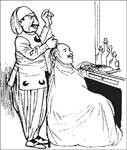Hair transplantation is not a new surgical procedure although its sophistication has greatly progressed over time. Below is a brief overview of the history of hair transplantation.

Menahem Hodara (1869 − 1926) an Ottoman dermatologist, is thought to be the first to carry out this procedure. Although he is also acclaimed internationally for a number of other contributions to medicine in a career spanning 36 years, none of his contributions became as popular in his time as his hair transplantation experiment in 1897, which fell into oblivion after his death in 1926.
An imaginative cartoon of Dr. Hodara as a hairdresser was published in Musée des Familles in 1899 (Courtesy of the Bibliothèque Nationale de France, Paris)
During the decades following Hodara’s experiment, several distinguished dermatologists, including Schweninger, Kromayer, Székely, and Kapp, published articles on scalp hair grafting, demonstrating that success occurred when a restricted number of hairs were planted in a small area.
The 1930s marked the true beginning of more advanced hair replacement surgery with great achievements accomplished mainly by the Japanese School of Dermatology. Sasagawa proposed a novel method for insertion of hair roots (1930), Passot succeeded in moving hair from a viable hair-bearing part of the scalp to a bald area (1931) and Okuda used cylindrical punches of hair from a donor site (1939). Moreover, Fujita succeeded in grafting scalp fragments on the eyelid regions of lepers in 1953.
The hair transplantation technique of modern days, however, was developed in the early 1950s by Dr. Norman Orentreich in the United States. He developed the concept of “donor dominance” to explain the ability of the transplanted hair to retain the same characteristics of the hair from where it was taken.
Punch grafts or “plugs,” were introduced in the 1970s although with less than satisfactory cosmetic results.
At the International Congress of Plastic Surgeons in 1975, Juri presented a flap procedure that bears his name. In Juri’s procedure, two long flaps of hair-bearing scalp were used to cover bald regions.
The following decades also saw considerable progress in hair transplantation and the introduction of “follicular unit transplantation” which was introduced in the 1990s by Dr. Robert Limmer of Texas. This technique is today the most successful form of hair transplantation as a truly natural look is possible thanks to individually transplanted hair follicles.
This type of transplantation requires great skill, experience, artistry and a large team as is the case at HRBR.










